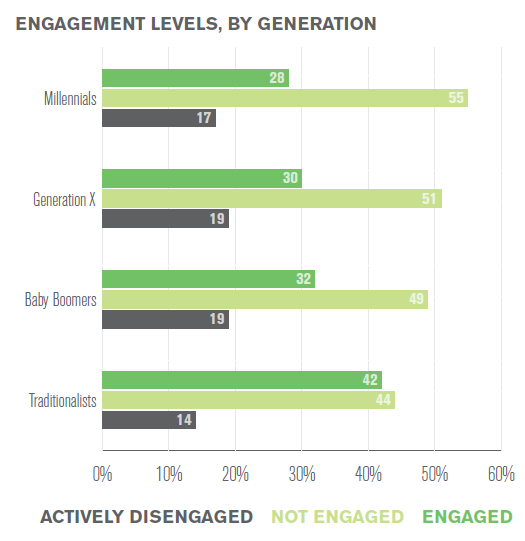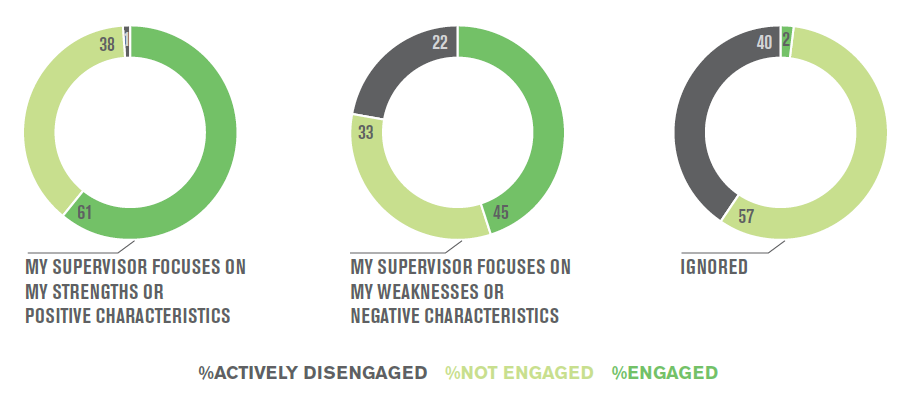If you ask successful auto dealership owners and managers how they succeed, most will magnanimously say that their greatest asset is their employees.
 But according to Gallup's 2015 report, State of the American Workplace, that's "only true when those employees are fully engaged in their jobs."
But according to Gallup's 2015 report, State of the American Workplace, that's "only true when those employees are fully engaged in their jobs."
And 70% of American workers aren't.
Fully engaged employees solve more problems, perform better during a crisis, get sick less often, and rarely cause accidents.
And "they are the only people in an organization who create new customers."
Want more of them?
Disengagement Costs
The study discovered some solid methods for creating them, but let's look at the challenge first.
Disengaged employees, maddeningly, are "hard to spot."
They're not hostile. They're not disruptive. They're not even late -- they're just punching the clock and going through the motions. "They show up and kill time," the study found, "with little or no concern about productivity, profitability, waste, safety...or developing customers."
They fall into two categories. Most of them, 52% of all employees, are "not engaged," behaving like typically lethargic people doing just enough to get by. And maybe that's good enough for them.
The real problem begins with the "actively disengaged," 18% of all employees, who express their discontent by trying to un-do whatever positive impact a fully engaged employee might have.
This is not a Millennial problem or a post-crisis problem, either. It seems to be a stable fact of life; Gallup has conducted this study eight times since 2000, and over that time "workplace engagement levels have hardly budged."
Since the numbers remained consistent all through the Great Recession, they're almost certainly stable and reliable indicators.

Gallup calculates that the "actively disengaged" cost the country between $450 billion to $550 billion per year.
But they don't impact every company equally.
Gallup ranks the companies into four groups by how engaged their employees are. The results are astounding.
The top fourth of companies were 22% more profitable than the bottom fourth. They were 21% more productive, 48% safer, and they had far better absenteeism and turnover rates. They also "have higher earnings per share and seem to have recovered from the recession at a faster rate." At the extremes, companies in the top 1% enjoyed financial and business performance four times as high as those in the bottom 1%.
All because their employees were fully "engaged."
Secrets to Engaging Employees
Engaged employees "are 100% psychologically committed to their work." How would you create one? Is it possible to encourage ambivalent employees to become engaged?
The answer is yes, but a qualified yes. Employee perks don't help, believe it or not. They might improve morale, but they don't create engagement.
Engagement begins with understanding. The study found that "only 41% of employees felt that they know what their company stands for and what makes its brand different from its competitors."
All of your engaged employees are in that group because they all "know the scope of their jobs and look for new and better ways to achieve outcomes."
One way to increase the potential of every employee is to make sure they know what the company stands for and what makes it better -- in other words, have them memorize your Mission Statement and Core Values. (If you don't have these things, you need them, because your engaged employees need them, too.)
The study found that the best way to leverage that understanding is to focus on each employee's strengths. That, they found, "is a far more effective approach than trying to improve weaknesses."
Focusing on strengths means measuring something directly related to that strength. Say one of your service estimators is particularly good at selling preventative maintenance. If that's his strength, the temptation might be to measure how many preventative jobs he sells and perhaps spiffing him for hitting a sales goal.
The study suggests that's not the best approach. "Measurement without targeted action is useless," they discovered, adding that "many [managers] persist in measuring performance by the wrong standard — using unsubstantiated or ineffective metrics that ultimately lead nowhere."
They found that what you want to do is to reward the actions that create the preventative maintenance sale. Rather than spiff him for sales, spiff him for checking every vehicle for a preventative opportunity, and for presenting that opportunity to the customer as clearly as possible. A sales goal is abstract and difficult to control; but checking a vehicle and presenting an option are concrete and completely within the estimator's power to do.
That has great potential to create a fully engaged employee -- but since you're the leader, you have to follow through to make it work. When that employee proudly shows his manager that he checked every vehicle and presented options every time it was appropriate, you and that manager need to acknowledge his job well done. If you included a spiff, then you need to pay it promptly and set him up to do it again.
Why? Because "if employers do not follow up on engagement results, employees’ disengagement may actually increase."

Once you have that employee checking and presenting, you can rest assured that the sales will follow as a matter of course (assuming you have all the tools you need to close them). Since you focused on the employee's strengths, you've kept him in his comfort zone and you've enabled him to unabashedly form an emotional bond with the customer.
That's golden. In fact, the "emotional connection between employees and customers must be central to what leaders and managers think about every day...If they do not focus on this connection, missed opportunities to maximize employees’ efforts quickly result in missed [business] opportunities..."
Any employee working in such a highly functional environment would not only be "100% psychologically committed," they would also be 100% business committed. They'll want to close additional jobs, and they'll want to bring in all the revenue they can.
So be sure you follow-through for your employees in another way: give them a payment option they can offer to customers that isn't financing, that doesn't require a credit check, but that can match payments to the customer's cash flow. Some of our auto dealership clients have seen a 100% increase in their service department revenues thanks to this service.
We try to treat our clients the way you treat your employees because, as the study concluded, "the best performing organizations have an unparalleled commitment to their people." Let us prove it to you today.



